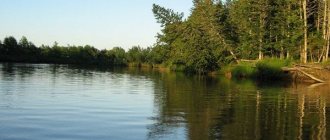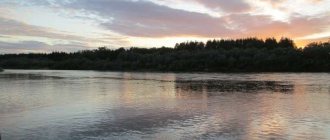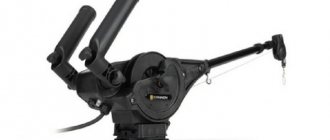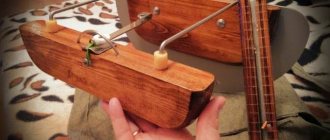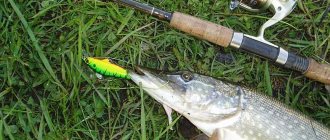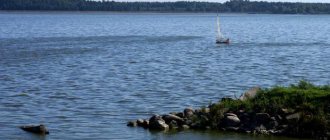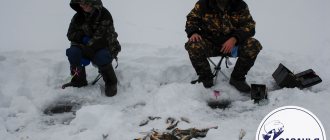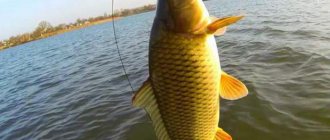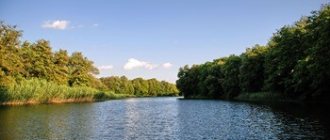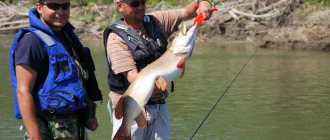Residents of northern reservoirs
The northern part of the country is rich in water resources, many rivers flow here, and there are many natural lakes. In addition, fisheries are constructing artificial reservoirs for growing and fishing different types of fish.
There are a sufficient number of freshwater fish species in natural reservoirs; most often you can catch them completely free of charge. People go north mainly for predators, but peaceful species of decent size are also caught here.
Grayling
The cool waters of northern reservoirs have become a permanent place of residence for grayling, which is abundant in the local water area. They fish it with fly fishing and spinning gear. Fishing is also carried out in winter; ice fishing in the north for grayling can be more successful than in open water.
The catch is made using artificial bait; the fish responds well to:
- small flies that look like caddisfly larvae;
- small rotating spoons;
- small oscillating spoons.
It is best to choose mountain rivers with a rocky bottom and clear water to catch grayling. There are especially many grayling in the reservoirs of the Arkhangelsk region, in the north of Karelia and in Yakutia.
Pike
Fishing in northern Siberia will become a place for catching very large specimens of this predator; the region’s reservoirs are capable of raising pike weighing up to 12 kg. It is fished throughout the year; fishing in open water is carried out with girders off the coast, as well as with spinning rods. You can lure pike by casting or trolling with the following types of bait:
- large wobblers, the depth of which is determined depending on the time of year and the reservoir chosen for fishing;
- copper-colored and large-sized vibrators, silver and gold ones will not work as efficiently;
- large spinners, you should use spinners starting from No. 5 and larger;
- soft silicone versions with a jig will also perform well; the weight and color are selected individually.
Victoria Leshchenko
I've been working hard in the fishing tackle department for the past six years. I can help you assemble almost any gear.
Ask a Question
Poppers, spinner baits and garlands of wobblers will work well when trolling.
Perch
Locals rarely go fishing for perch; for them it is not a trophy. On the contrary, visiting fishermen get great pleasure from catching hefty perches. They are caught with spinning rods, using spinners or silicone baits with a jig or moving rig.
When catching perch in the northern regions, it is not necessary to use silicone from the edible series; the minke whale responds well to the most primitive options.
Burbot
You should go to the reservoirs for it at the end of winter, beginning of spring. It is during this period that the cod brother begins to feed especially actively and becomes less cautious. The capture is carried out using bottom gear; the bait chosen is:
- small-sized baitfish from a given reservoir;
- lumpy purchased fish;
- crustaceans.
Chicken liver would be a good option; local avid fishermen use this bait to catch the largest burbots.
Som
The region also fishes for bottom predators, and the most suitable time would be autumn. Spinning rods with high dough, as well as bottom gear, are used for catching. On a spinning blank, catfish are excellent for catching with dark-colored silicone baits, they will respond to a large spinner, and sometimes they will not disdain a wobbler.
Bottom gear is made from thick versions of the base and leader, hooks are selected large and of good quality, and the best options for bait are:
- dead fish;
- liver;
- bunch of worms
The best time to go for catfish is at night.
Taimen
The most famous representative of the fish of the northern rivers is taimen; fishing for it is prohibited, as it is listed in the Red Book. All caught specimens are immediately sent back to the reservoir, only photos are taken as a souvenir.
Sport fishing is often carried out in the region; taimen are regularly caught on the hook; they are attracted by flies, silicone baits, and wobblers.
They also fish for peaceful fish in the region; there is also enough for everyone here. Local residents often place nets in small reservoirs for fishing for crucian carp, in order to free up some space for other types of fish.
crucian carp
Few locals make a living here by catching crucian carp, but for visiting crucian carp hunters this place is simply paradise. Crucian carp can be caught both on a float and on a feeder, and larger specimens will prefer bait and feeder tackle. Bait can be very diverse:
- bloodworm;
- worm;
- maggot;
- corn;
- pearl barley;
- dough;
- mini boilies.
It is necessary to feed only using bottom gear, and even then not always; in the hottest time of the year, namely in July, no trick will help. The rest of the time, crucian carp will be caught just fine.
Carp
Carp fishing is thriving, fishing is interesting, and the results will definitely please you. You can fish for a decent option using a feeder rod, using the following baits:
- corn;
- worm;
- peas;
- boilies;
- mini boilies;
- maggot;
- dough;
- artificial types of cereals.
Victoria Leshchenko
I've been working hard in the fishing tackle department for the past six years. I can help you assemble almost any gear.
Ask a Question
The equipment should be made of high quality; a trophy carp can give a worthy rebuff to a fisherman.
Bream
Fishing for bream will bring a lot of pleasure, the main thing is to collect stronger gear and use the right bait. In the reservoirs of the northern region you can catch trophy specimens; bream weighing 3 kg is often caught. They fish it with a feeder and a bottom, using worms, maggots, and bloodworms as bait; the humpback will also respond to corn and peas.
Fishing in the Perm region
The Northern Urals are famous for the purity of cold rivers and streams, which are home to the powerful predator grayling. Its length reaches 50 cm, weight 2.5 kg. Recommendations for fishing for this beautiful breed:
- A successful period of combining rest with the prey of a smart and strong opponent lasts from June 15 to the end of September. If summer is delayed, then the beginning of the season is shifted to July.
- Grayling fishing spots are determined by the presence of a current of medium intensity with rifts and a depth difference of 1-2 m. Usually the predator is located at the transition to shallow water, and the soil in this current should be hard - rocky-sandy. A muddy bottom and weak movement are more suitable for pike, and grayling does not swim into such places. It’s good if the riffle is found within 1 km from the mouth, but the predator can also be caught directly at the point where the river flows into the lake.
- The spinning rod is selected based on the size of the fish in a particular body of water, the weight of the bait and the required casting distance. With an average current width of 60–100 m, the movement of the bait will be 30–50 meters and a 2 m long rod is quite suitable for convenient retrieves.
The weight of a fly or spinner fluctuates in the range of 7–15 g. According to this indicator, a test for a spinning rod is chosen - the value of the minimum and maximum weight of the bait. For fishing in hard-to-reach places, take a more powerful rod with a value of 28 g.
What kind of fish is found in the Arkhangelsk region
In the Arkhangelsk region, not only local residents, but also tourists engage in fishing. Many people come here just to enjoy active recreation on incredible rivers and lakes. An excellent catch awaits anyone, even in small bodies of water, because this area is famous for its diverse ichthyofauna. Some of the best fishing takes place on the White Sea, where especially valuable fish are found. The following fish are available in the Arkhangelsk region:
- Salmon;
- Brown trout;
- crucian carp;
- Bleak;
- Ide;
- Perch;
- vendace;
- Bream;
- Burbot;
- Zander;
- Roach.
Severodvinsk pit of CHPP-2 (from ice)
The pit, thanks to which CHPP-2 regularly operates, was launched quite a long time ago - in the mid-70s of the last century. It is fed from the Northern Dvina - this is a very deep river, which creates a very active current in the pit itself.
First of all, it is worth noting that the water movement in the pit is extremely uneven, which is why winter fishing is a rather dangerous activity. You can go out on the ice only when it has already gained the necessary strength.
You should move on the ice as carefully as possible, otherwise there is a risk of falling through - such cases happen there every winter.
There are many small islands, shallows and riffles in the pit. An important advantage of fishing in this area is permission to use almost all gear.
The following fish species bite here beautifully in winter:
- Bream;
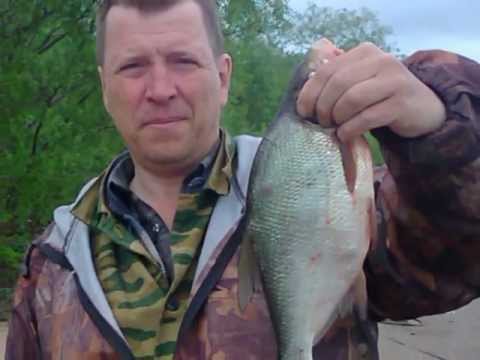
- Guster;
- Grayling;
- Roach;
- Perch;
- Ide;
- Pike and many others.
In some cases, salmon and salmon come here. Flounder can only be caught in the summer months, and even then it is found only in the Dvina itself, closer to the mouth, not reaching the pit.
Experienced fishermen advise catching pike with a balance beam or a jig in winter. They say this is the most interesting type of fishing. However, pike stop biting somewhere closer to mid-January, and strong ice only appears around the new year.
Because of this, fishermen have only two, maximum three, weeks to catch as many of these predatory fish as possible.
When severe frosts begin, pike almost stop feeding. As a rule, this occurs due to a lack of oxygen in deep water. She begins to look for the most comfortable places for herself, rising from her favorite holes closer to the surface.
She needs some time to get comfortable there, and besides, it is not at all a fact that even in the middle of a reservoir or under ice there will be enough oxygen. If you manage to come across such a site, it can be considered great luck.
With perch it is much easier in this regard. Throughout the winter period, it actively walks throughout the entire thickness of the reservoir in large flocks. This fish is not too sensitive to weather conditions and the amount of oxygen, so it continues to feed even in the most extreme cold. However, she also experiences slumps in activity.
In particular, in strong winds, during a thaw and during snowfall, the perch takes a slight break in feeding. At this time, catching perch is not very easy.
Fishing in the north
The Russian North is the endless expanses of Siberia, with pristine virgin nature and magnificent landscapes. The reservoirs located in the Russian North are a blessed paradise for fishing masters and novice fishermen. Fishing here is not the same everywhere, since the northern territories have their own specific climate. Therefore, the conditions for fishing vary. Northern reservoirs abound with a variety of fish species, which is very dear to the heart of an avid fisherman.
On the rivers of the Russian North, fishing lasts all year, and currently fishing tourism is gaining momentum in the Siberian region. Fishing clubs have already been created here, and their number is growing every day. The human factor has not yet had time to play its cruel joke, so the North of the Russian Federation is an ecologically clean region, and peace and tranquility created by Mother Nature reign here. The local reservoirs are home to all types of fish that are also found in central Russia. You can find carp, perch, carp, pike perch, bream and other fish.
But northern fishing is different in that, in addition to the classic species, you can also catch sturgeon, nelma, sterlet, broad whitefish, grayling, and muksun. There are about 37 species of northern fish belonging to twelve families.
In terms of its taste, Palearctic (northern) fish compares favorably with others, since in the harsh winter cold it is forced to gain fat. Therefore, fish meat is quite tasty and has a delicate texture. Local entrepreneurs have created all the conditions for comfortable fishing and recreation. There is no doubt that safe fishing involves using the services of paid fishing bases where fish are bred. Siberians do not welcome such fishing, because fishing without taking risks is not interesting. Visiting fishermen sometimes stop at such bases. In this case, you need to take more money with you. Fishermen relax here quite actively, temporarily becoming tourists. They go hiking and spend the night in tents. They can raft down the fastest and calmest rivers, striking the imagination with their beauty.
Also interesting: Fishing in the Gulf of Odessa - an overview of coastal fish species
But you can go fishing yourself, as a “savage”, so to speak. And even if you choose this type of fishing, the locals, who are distinguished by their hospitality and hospitality, will definitely help you. If you want, they will be your guides.
Fishing for fish such as grayling, which is omnivorous, is very popular. It can be caught using fly baits and natural baits. Grayling does not disdain dead insects. To catch this fish, you need to go as far as possible from the populated area.
Muksun has an unsurpassed taste and is the most important commercial fish in Siberia. In many Siberian regions, fishing for this fish is prohibited. But where possible, it is caught using commercial fixed nets or floating nets. Masters of fishing art make baits that resemble various insects and amphipods, since muksun likes to feed on insects that live under water. Some novice fishermen believe that this fish is caught with some special bait. But this is a myth. Professionals say that the main thing is that the bait looks like a natural insect. Muksun cannot become infected with opisthorchiasis larvae. Thanks to this, stroganina from this fish, in addition to being a “gourmet feast” and a delicacy, is a completely safe dish. It is curious that freshly caught fish smells like fresh cucumber.
Chir, or shokur, is divided into two subspecies: river broad and lake-river. Shchukur chooses mollusks for food; insects are also in his honor, and he bites on them. In addition to natural bait, whitefish are also caught using artificial bait. They are placed on a spinning fishing rod or a regular one.
The sturgeon family, which is found in the north-south part of Siberia, includes sterlets and Russian sturgeons. Sterlets form schools and feed on insects and their larvae. However, there is a restriction on sturgeon fishing: you can only catch it for money and in a certain quantity. The largest representatives of whitefish include nelma. If not caught, she grows up to ten kilograms. As a rule, it is found in large Siberian rivers: Lena, Ob, Yenisei, Irtysh. Nelma is a very shy and cautious fish, and this fact must be kept in mind when catching nelma. It is caught using narrow oscillating spoons or spinners. Nelma, just like muksun, smells like fresh cucumber. And even after freezing, this smell remains, but it is not as bright as freshly caught fish.
Also interesting: Desna fishing
Local fishermen advise coming to the northern territory of Russia for fish in the autumn season. In autumn, the forest dresses up in elegant clothes of amazing beauty and variety, and the fish prepare for the winter cold. However, a fishing trip to the Russian North surprises you with its beauty and fishing spots at any time.
Author: N.K
Category: Fishing spots
Where to fish
The Arkhangelsk region is the north of the East European Plain, next to the Arctic seas and far from warm currents. The region belongs to the territories of the Far North: winters here are cold, and summers are short and not hot.
Fishing in Arkhangelsk
There are several options for fishing in Arkhangelsk. The simplest and most accessible is fishing within the city from the Northern Dvina embankment. However, it is worth remembering that there are environmental problems here. But for now you can still catch ruffs and perches, and experienced anglers can count on pike and whitefish.
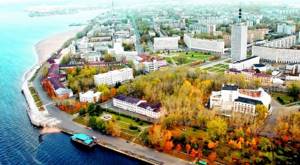
Arkhangelsk
Vyselki Island. This is one of the most favorite places for fishermen. In the area of Khabarka, Pustosh and Vyselok and in the channels of the Khabarka River you can catch pike, perch, ide, and bream.
You can get to Vyselki by boat, which departs from the pier in Solombala.
Yuras River. Fishing competitions are regularly held here. It bites both in summer and winter. The river practically does not freeze and quickly becomes free of ice. There are burbot, ide, bream, sometimes flounder and other types of fish are found.
You can approach the river in different ways, for example, from the Talazhskoye Highway and move towards the reclamation station. Either at the confluence with Kuznechikha, next to the Talazhsky industrial hub, or at the Zharovikha railway station.
Sea fishing
Paranikha Bay. The bay is rich in navaga and flounder. They are caught mainly from boats or using hooks. Sea worms, mackerel, shrimp and squid are used as bait. This place is located in Severodvinsk, next to the bridge over the Kudma River.
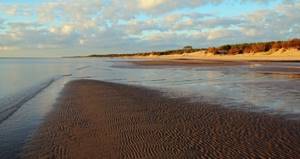
White Sea near Severodvinsk
Unskaya lip. A place where every fisherman should visit. In the summer, White Sea cod and catfish are caught in Unskaya Bay. In autumn - navaga.
Unskaya Bay is an area for preserving the navaga population and to be in it you must purchase a ticket.
Lakes
Lake Slobodskoe. The area of the lake is 12.2 kilometers, the water is clean, transparent, and at the bottom there is sand and silt. It is home to burbot, perch, pike, roach, whitefish, bream, and ide.
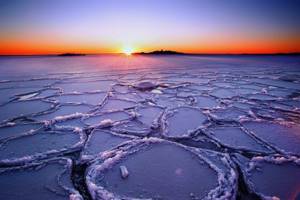
Lake Slobodskoe
Many people come to the lake not only for fishing, but to swim, breathe fresh forest air and enjoy the peace and quiet.
Lake Travnoe. Fishermen have different opinions about the lake - some say that after the first unsuccessful bite they will never set foot here again, while others, on the contrary, consider the lake one of the most fishy.
People come here for both winter and summer fishing. Perch, sorog, pike, burbot, and many small ruffs bite with varying success.
Lake Chidvozero. To get to the lake, you must first drive to the village of Izhma, then through the checkpoint along the Severalmaz technological road. In Chidvozero you can catch perch, pike, whitefish and, of course, bream.
To the east there is another fishing place with a telling name - Leshchevo.
Fishing in neighboring regions: Republic of Karelia, Murmansk region.
